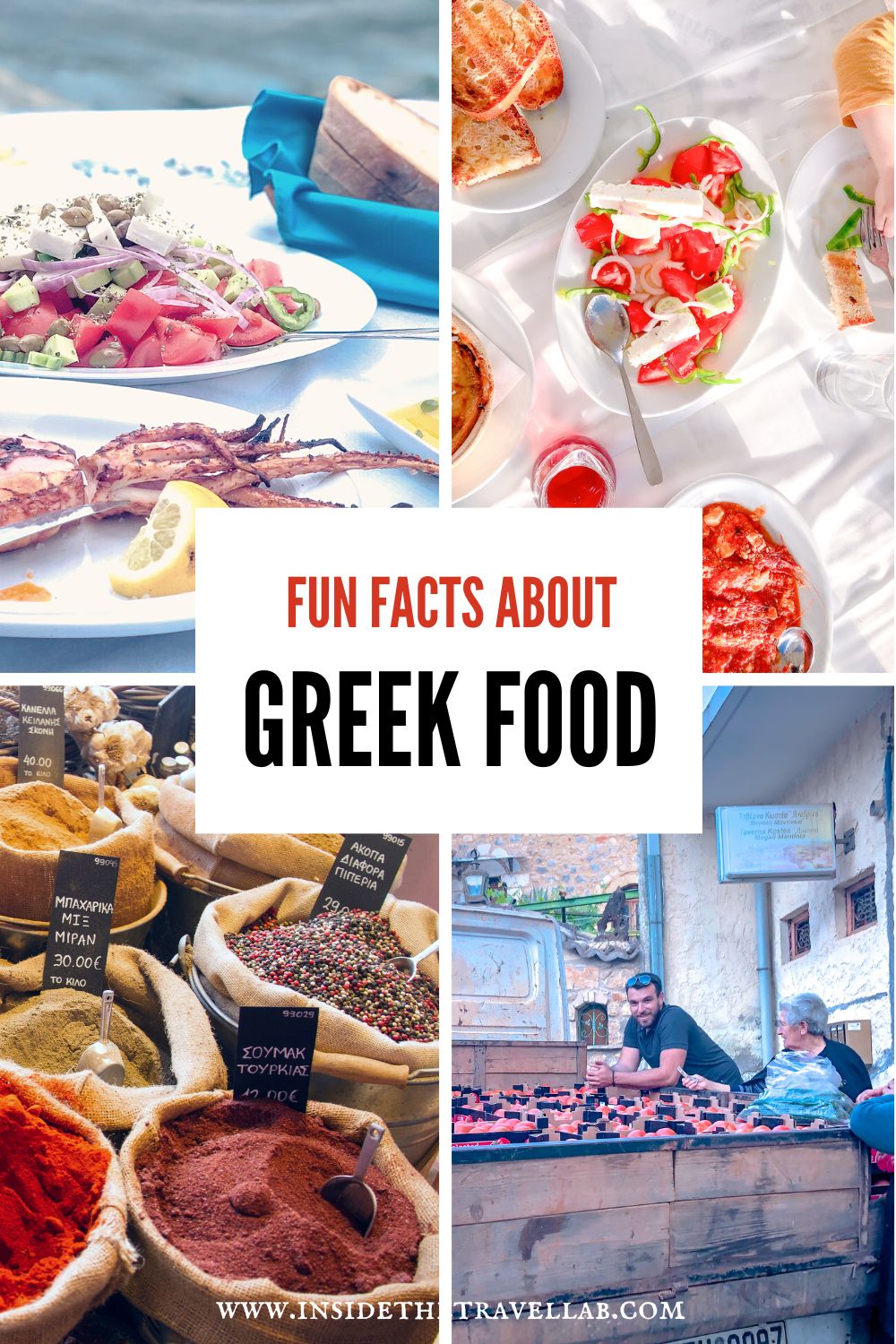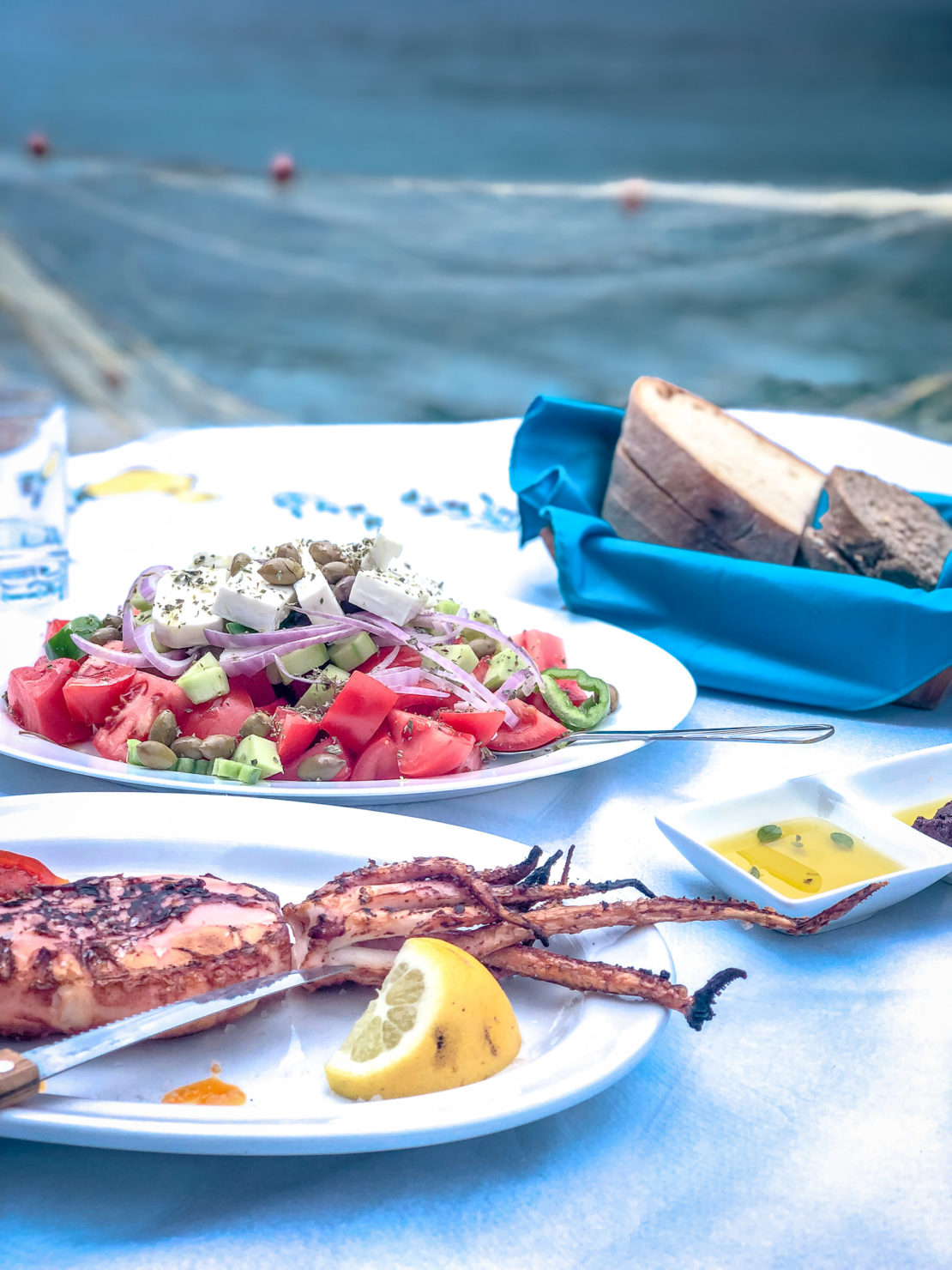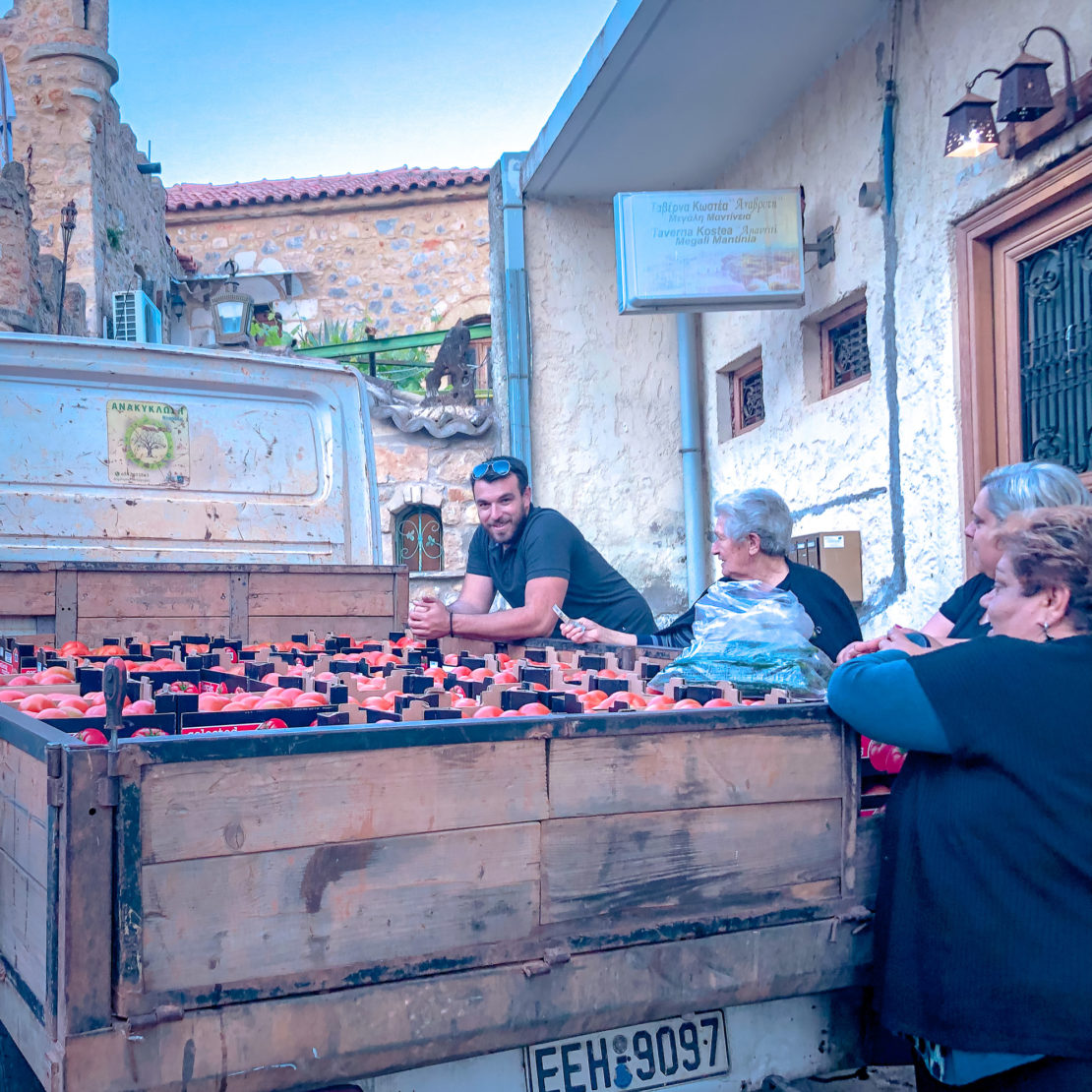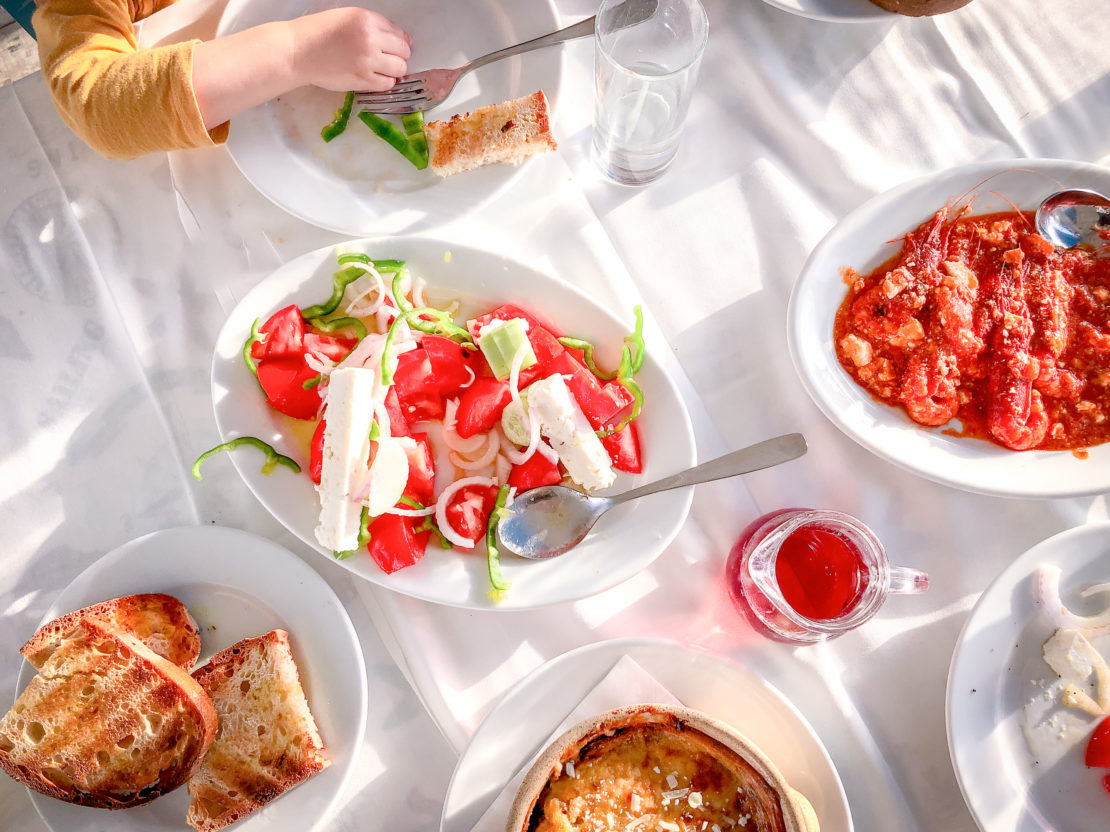Pull up an appetite and enjoy these stories and fun facts about Greek food.

Interesting and Fun Facts About Greek Food
Did you know that Greece produces some of the best olive oil in the world? Or that the origins of feta cheese date back to ancient times?
Join us on a voyage of discovery as we delve into the rich culture and tradition of Greek food, uncovering some fascinating facts along the way.
How to make it happen
Of course, the best way to taste Greek food is to travel to Greece yourself! Greece is popular among tourists for its pristine beaches, mesmerising blue waters and 5-star resorts. But apart from basking in the sun or relaxing in luxury villas in Lefkada, you know what else can make your stay in Greece memorable?
Checking out these fun facts about Greek food for yourself. By trying the dishes yourself.

Greek Cuisine is over 4,000 Years Old
Have you ever wondered about the origins of Greek cuisine? Well, let’s take a trip back in time to ancient Greece, where the foundation of traditional Greek food were laid.
The Greeks had a deep appreciation for food and considered it an integral part of their culture. Yet for them, food was not only a great meal but a way to honour the gods.
Legend has it that the Ancient Greeks drew inspiration for their culinary creations from the divine beings on Mount Olympus, who would bestow good fortune upon them as a reward.
For the inhabitants of Ancient Greece, the main food source was grain, and bread was a staple in their diet. It was often eaten with olive oil or dipped in wine for added flavour. This diet provided the necessary nutrients for their physically demanding lifestyle.
Surprisingly, tomato sauce didn’t arrive until the 18th century. Before that, Greeks used olive oil as a base for many of their dishes. For special occasions like weddings and festivals, meat was added to the menu as a special treat.
One of the main reasons Greek cuisine has stood the test of time is its focus on fresh, high-quality ingredients. Even today, traditional Greek dishes are made using fresh ingredients, reflecting the country’s deep culinary heritage.
So, the next time you enjoy a Greek meal, remember that you may be trying a dish that was invented 4,000 years ago.

Greeks Love Their Olive Oil
Standing under the shade of an olive tree in Greece is a humbling experience, knowing that it might have graced the earth for thousands of years.
In fact, one of the most interesting facts about Greek food is that some olive oil comes from trees that are more than 6,000 years old. According to Greek mythology, the goddess Athena gifted the olive tree to the people of Athens, which earned her the city’s patronage.
This ancient gift has certainly lived up to its worth, as olive oil quickly became one of the main ingredients of the Mediterranean diet and played an important role in Greece’s economic growth.
Today, Greece is one of the biggest olive oil-producing states in the world, yielding over 300,000 tonnes of olive oil each year from an impressive 132 million olive trees.
Most of this is extra virgin olive oil, which is a sign of its high quality and cold-pressed production. The Greeks use this liquid gold to cook a vast array of dishes, from salads and dips to grilled meats and fish, as well as traditional Greek sweets like baklava and koulourakia.

In Greece, Feta Cheese Rules
Feta cheese is more than just a food item – it’s a cultural icon in Greece. The tangy and salty taste of this traditional cheese has been savoured by Greeks for centuries, dating back to ancient times. Originally made from sheep’s milk and stored in brine, feta has a rich history closely tied to the Greek way of life.
From classic Greek salads to savoury pastries like spanakopita, feta cheese plays a leading role in many traditional Greek dishes. However, it is not just limited to those – it is also a favourite table cheese, often served with bread, olives, and wine.
In fact, feta cheese is so crucial to Greek culture that it has been protected under European Union law since 2002. Only cheese produced in Greece using specific ingredients and methods can legally be called “feta.” This ensures that traditional feta-making practices are maintained and that the cheese remains of the highest quality and authenticity.
Today, feta cheese can be found in Greek restaurants all over the world. It is often featured in mezze platters alongside other Greek delights like dolmades and tzatziki. And in Greece itself, locals can purchase fresh feta by the kilo at local markets, ensuring that its quality and freshness are second to none.
The Greek Diet Is One of the Healthiest on Earth
The culinary traditions of the Ancient Greeks have inspired a diet that has stood the test of time. The Greek way of eating celebrates the goodness of natural, unprocessed foods and embraces the benefits of healthy fats such as those found in nuts and olive oil.
On the island of Crete, known for the longevity of its inhabitants, a cuisine based on plant-based foods, fresh fish, and herbs is revered, with the star being the crisp Greek salad, bursting with juicy tomatoes, crispy cucumbers, and tangy olives, and finished off with creamy feta cheese and a generous squeeze of lemon juice.
Despite the rising trend of fast food in Greek cities, many still choose to honour their roots and prioritise wholesome, fresh foods that are both satisfying and nutritious. The traditional Greek diet is a testament to this commitment, with an emphasis on whole, unprocessed foods like Greek yoghurt, fresh fish, and a rainbow of fruits and vegetables.
Roman, Persian, and Ottoman Influences
Greek cuisine has been influenced by neighbouring civilisations such as the Roman, Persian, and Ottoman empires, all leaving their mark on Greek culinary culture.
The Roman Empire brought with it an appreciation for dairy products and cheese, teaching the Greeks new cheese-making techniques, such as ageing cheese. Romans also introduced sesame seeds, which are now a part of many Greek dishes, including bread, dips, and desserts.
The Persian influence can be seen in the use of vine leaves and fennel seeds, which were popular ingredients in Persian cuisine. Greeks adapted these ingredients to create classic dishes such as dolmades (stuffed vine leaves) and fennel pie.
Last but not least, the Ottoman Empire, which ruled over Greece for centuries, left its mark on the Greek meal with small dishes like mezze, reminiscent of the Middle Eastern style of eating. Ottomans also introduced green peppers, which became a widespread ingredient in Greek dishes such as spanakopita (spinach pie) and tyropita (cheese pie).
Meals In Greece Are Social Events
Greece is a country that knows how to dine! Meals are more than just food. They are a celebration of life, love, and friendship. And no Greek feast is complete without the iconic pitta bread. Picture this: a warm, fluffy pitta, fresh from the oven, served alongside a colourful display of dips like creamy hummus and tangy tzatziki.
As you break off a piece of bread and dip it into the flavourful spreads, you are transported to a world of communal dining where the sharing of food brings people closer together. It’s a lively and interactive experience, with plates of food passed around the table family-style so everyone can try a little bit of everything.
And the best part? The leisurely pace of the meal means there’s plenty of time to savour each bite, relax, and enjoy the company of those around you. With pitta bread at the centre of it, every Greek meal is a celebration of culture, community, and delicious cuisine!
In Greece, You Linger Over Your Coffee for Hours
Greek coffee is brewed with finely ground beans and served in small cups. But it is not just a beverage. It is a ritual that Greek people savour for hours and a practice that is deeply embedded in Greek culture.
As they slowly sip their coffee, the Greeks take their time to appreciate each moment, engaging in deep conversations with family and friends. It is a slow process that allows them to take a break from their otherwise fast-paced life and reconnect with themselves and others.
And let’s not forget the enchanting practice of fortune-telling. After drinking their coffee, some Greeks turn the cup upside down, watching in awe as the patterns and symbols left by the remaining coffee grounds reveal their fortunes.
The Greeks Invented the Frappé
The energising frappé is believed to have been invented in Greece in 1957 by a Nescafé representative named Dimitrios Vakondios. Vakondios reportedly wanted to showcase Nescafé’s instant coffee in a new way, so he mixed it with cold water in a shaker until it became frothy and poured it over ice. The result was a refreshing drink sold at an affordable price that quickly became popular in Greece and beyond.

Santorini Grows Unique Volcanic-Soil Cherry Tomatoes
The exceptional taste and quality of Santorini’s cherry tomatoes have made them famous worldwide, and rightly so. These tomatoes are cultivated on the island’s circular plots, known as “pezoules,” and are protected from harsh winds and sunlight by low stone walls.
The volcanic soil, warm climate, and dry weather conditions on the Greek islands provide the perfect environment for growing these delicious tomatoes.
They are a prized ingredient in many Greek dishes and have earned the Protected Designation of Origin (PDO) status by the European Union, ensuring that only tomatoes grown in designated areas of Santorini using traditional methods can be labelled as “Santorini tomatoes.”
Ancient Greek Athletes Boosted Performance with Garlic
In ancient times, when mighty warriors roamed the land and gladiators fought to the death, the Greeks discovered the powerful health benefits of garlic. They revered the pungent plant, believing it to be a source of invincible strength and endurance. The Greek athletes consumed garlic before battles, convinced that its mystical properties could stimulate their bodies to produce adrenaline, the very essence of raw power. They were right, in a way, for garlic increased blood flow to their muscles, granting them superhuman strength and an unbreakable will to win.
Vasilopita: The Greek New Year’s Eve Tradition
Vasilopita is a delicious cake cherished by Greeks around the world, and it is especially significant during New Year’s Day celebrations. Named after Saint Basil, this decadent dessert is made with luxurious ingredients like orange zest, nuts, and raisins, and it’s topped off with a hidden treasure: a coin or trinket that brings blessings and prosperity to the lucky person who finds it in their slice of cake.
But Vasilopita isn’t just about the sweet stuff – it’s also a time-honoured tradition that brings families and communities together to share in the joy of the season.
The Greekest of All: If You Lost Something, Bake a Fanouropita!
Fanouropita is a traditional Greek cake baked in honour of Saint Fanourios, a lesser-known saint in the Greek Orthodox Church. It is made with simple ingredients and garnished with nuts or raisins.
What makes this cake unique is its association with a specific prayer to Saint Fanourios, also known as the patron saint of lost items.
According to tradition, if someone has lost something and prays to Saint Fanourios while baking the cake, the lost item may be found soon after.
The tradition of making Fanouropita is closely tied to the concept of name days in Greece.
Each day of the year is associated with a particular saint, and people named after that saint celebrate their name day on that date. Saint Fanourios is celebrated on the 27th of August, and it is on this day that the cake is traditionally baked and shared with loved ones.
Another little-known fact about Fanouropita is that it is a way of introducing oneself to new neighbours or friends. It is customary to bake a cake and offer it to the new arrival as a way of welcoming them to the community.

Fun Facts about Traditional Greek Dishes
Gyros
It’s only appropriate to start the list with one of the most popular Greek street foods – gyros. You’ve probably tried gyro or variations of it before, but we can assure you it tastes differently in its homeland. This warm pita filled with seasoned meat, be it beef, lamb, chicken or pork cooked on a vertical rotisserie, and served with a variety of toppings such as tomato, onion, tzatziki and French fries, is going to fill your stomach and your heart.
Souvlaki
The Greeks are masters of roasted and grilled meats, a point proven by another all-time classic street food: souvlaki. It’s made with small pieces of pork or lamb marinated in lemon, olive oil, and balsamic vinegar then placed on a skewer and cooked over an open fire. It’s usually served with pita, vegetables and tzatziki.
Greek Salad
After all this talk about meat and street food, a salad would be more than welcome. But the traditional Greek salad or horiatiki is quite different from the leafy salads most people are familiar with. Tomatoes, cucumbers, onion, green pepper, Kalamata olives and feta cheese are the main ingredients. Add a sprinkle of salt, oregano, olive oil and capers on top and you’re in for a feast.
Taramasalata
If appetisers are your thing, you must give taramasalata a try. Greeks are famous for their dips and this one is definitely a favourite. The dish is made with the salted and cured roe of cod, carp, or grey mullet mixed with olive oil and lemon juice. You can serve this creamy blend as a spread on potatoes or bread, and pair it with ouzo for an authentic Greek experience.
Dolmades
No trip to Greece can be complete without dolmades. The dish is traditionally made with a vegetarian blend of rice, onions, and aromatic herbs wrapped in cabbage or vine leaves and baked in the oven. However, there are many variants of dolmades, depending on the region, so we encourage you to try a few different ones.
Moussaka
If hearty meals are your cup of tea, moussaka is a dish you’re definitely going to enjoy. Think thick layers of tender aubergines, minced meat, and tomato puree topped with creamy bechamel sauce and cheese. Perfect for the cooler months.
Lamb Kleftiko
Lamb is a staple ingredient in Greek cuisine, so a traditional dish like lamb kleftiko is a must-try. The dish consists of pieces of lamb marinated in garlic, olive oil and lemon juice and slow-cooked in parchment paper with potatoes and vegetables.
Tzatziki
This creamy dip is made from a simple combination of Greek yoghurt, cucumber, garlic, lemon, olive oil and fresh herbs, and can be served on pita or paired with all sorts of dishes.
Loukoumades
If you have a sweet tooth, you don’t want to miss loukoumades. These are bite-sized sweet doughnuts, crispy on the outside and soft on the inside, made from loose yeast dough and traditionally served with hot honey syrup, cinnamon and walnuts or sesame seeds.
Tyropita
If you have room for one little snack, we recommend tyropita, a popular Greek pastry made with layers of phyllo dough and stuffed with feta cheese or some other delicious filling that goes perfectly with a cup of coffee.
More Greece Travel Guides
Start with our collection of beautiful and unusual things to do in Greece and then delve deeper into the Greek archives. Decide between Mykonos or Santorini with our guide to both islands.
In particular, look for the Peloponnese road trip itinerary and guide to things to do in Kalamata and these ultimate Peloponnese itineraries.
And don’t forget Athens (as if you could!) Find unusual things to do in Athens, retrace the steps of Plato with a philosophy tour and indulge with our Athens Food Guide.
Lastly, of course, don’t forget this packing list for Greece.
Enjoy!

